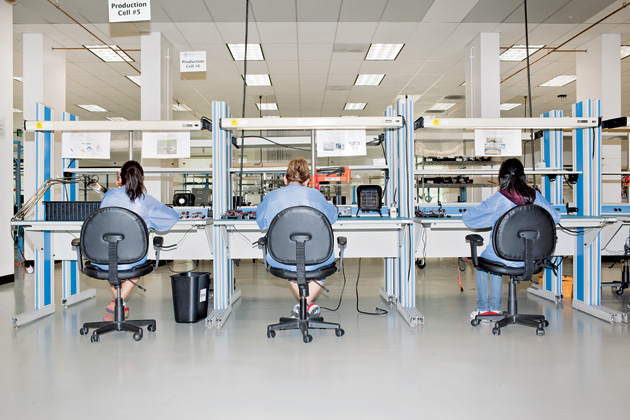Small U.S. Manufacturers Give Up on 'Made in China'
David Rocks and Nick Leiber
When Sonja Zozula and Jerry Anderson founded LightSaver Technologies in 2009, everyone told them they should make their emergency lights for homeowners in China. After two years of outsourcing to factories there, last winter they shifted production to Carlsbad, Calif., about 30 miles from their home in San Clemente. “It’s probably 30 percent cheaper to manufacture in China,” Anderson says. “But factor in shipping and all the other B.S. that you have to endure. It’s a question of, ‘How do I value my time at three in the morning when I have to talk to China?’ ”
As costs in China rise and owners look closely at the hassles of using factories 12,000 miles and 12 time zones away, many small companies have decided manufacturing overseas isn’t worth the trouble. American production is “increasingly competitive,” says Harry Moser, founder of the Reshoring Initiative, a group of companies and trade associations trying to bring factory jobs back to the U.S. “In the last two years there’s been a dramatic increase” in the amount of work returning.
An April poll of 259 U.S. contract manufacturers—which make goods for other companies—showed 40 percent of respondents benefited this year from work previously done abroad. And nearly 80 percent were optimistic about 2012 sales and profits, according to the survey by MFG.com, a website that helps companies find manufacturers. “A decade ago you just went to China. You didn’t even look locally,” says Ted Fogliani, chief executive officer of Outsource Manufacturing, the San Diego company working with LightSaver. “Now people are trying to come back. Everyone knows they’re miserable.”
For LightSaver, the decision was simple. Neither of the founders has ever been to China, which made communicating with manufacturers difficult. Components that were shipped from the U.S. sometimes got stuck in customs for weeks. And Anderson had to spend hours on the phone to explain tweaks in the product. “If we have an issue in manufacturing, in America we can walk down to the plant floor,” Anderson says. “We can’t do that in China.” Anderson says manufacturing in the U.S. is probably 2 percent to 5 percent cheaper once he takes into account the time and trouble of outsourcing production overseas.
Dana Olson makes a living convincing small manufacturers that it pays to produce domestically. About 10 percent of the roughly 60 companies that his Minneapolis firm, Ecodev, has worked with have moved manufacturing to the U.S. or decided not to send it overseas, and another half-dozen are considering similar moves. “There’s a growing sense, with the economy doing what it’s doing, of U.S. companies wanting to produce in the United States,” says Olson. “It’s very important to them to have ‘Made in the U.S.A.’ on their label again.”
Since 2008, Ultra Green Packaging, one of Olson’s clients, has used manufacturers in China to make compostable plates and containers from wheat straw and other organic materials. By yearend, Ultra Green expects to start producing the bulk of its wares at a plant in North Dakota to cut freight costs and protect its intellectual property. “They’re infamous over there for knocking [products] off,” says Phil Levin, chairman of the 10-employee company. “All anybody needs to do is find a different factory and make a mold.”
For Unilife, moving production to the U.S. helped it win regulatory approval for an important product: prefilled syringes with retractable needles that make it almost impossible for medical personnel to accidentally stick themselves. Although the company used Chinese manufacturers for earlier offerings, syringes preloaded with medications are subject to stringent U.S. Food and Drug Administration rules. So in March 2011, Unilife began making its syringes at a $32 million, 165,000-square-foot plant it built in York, Pa. “The very thing in the U.S.A. that oftentimes we complain about—the complexity of the rules and the regulations—works for us,” says CEO Alan Shortall. “FDA compliance is the main reason we’re here.”
Even with strong Mandarin skills, Brian Bethke grew frustrated with manufacturing in China. The co-founder of Pigtronix, which makes pedals that create electric guitar sound effects, discovered that he couldn’t adequately monitor quality at Chinese factories. The original idea for the company was to develop products in the U.S. and make them in China, where Bethke was living. But after several years of finding technical glitches in as many as 30 percent of pedals, the company decided to move production to Port Jefferson, N.Y. At its small factory in a Long Island office park, the company can run multiple tests on its products and even has a guitarist play each of the 500 to 1,000 pedals it sells monthly before they’re packed and shipped.
For LightSaver, the decision was simple. Neither of the founders has ever been to China, which made communicating with manufacturers difficult. Components that were shipped from the U.S. sometimes got stuck in customs for weeks. And Anderson had to spend hours on the phone to explain tweaks in the product. “If we have an issue in manufacturing, in America we can walk down to the plant floor,” Anderson says. “We can’t do that in China.” Anderson says manufacturing in the U.S. is probably 2 percent to 5 percent cheaper once he takes into account the time and trouble of outsourcing production overseas.
Dana Olson makes a living convincing small manufacturers that it pays to produce domestically. About 10 percent of the roughly 60 companies that his Minneapolis firm, Ecodev, has worked with have moved manufacturing to the U.S. or decided not to send it overseas, and another half-dozen are considering similar moves. “There’s a growing sense, with the economy doing what it’s doing, of U.S. companies wanting to produce in the United States,” says Olson. “It’s very important to them to have ‘Made in the U.S.A.’ on their label again.”
Since 2008, Ultra Green Packaging, one of Olson’s clients, has used manufacturers in China to make compostable plates and containers from wheat straw and other organic materials. By yearend, Ultra Green expects to start producing the bulk of its wares at a plant in North Dakota to cut freight costs and protect its intellectual property. “They’re infamous over there for knocking [products] off,” says Phil Levin, chairman of the 10-employee company. “All anybody needs to do is find a different factory and make a mold.”
For Unilife, moving production to the U.S. helped it win regulatory approval for an important product: prefilled syringes with retractable needles that make it almost impossible for medical personnel to accidentally stick themselves. Although the company used Chinese manufacturers for earlier offerings, syringes preloaded with medications are subject to stringent U.S. Food and Drug Administration rules. So in March 2011, Unilife began making its syringes at a $32 million, 165,000-square-foot plant it built in York, Pa. “The very thing in the U.S.A. that oftentimes we complain about—the complexity of the rules and the regulations—works for us,” says CEO Alan Shortall. “FDA compliance is the main reason we’re here.”
Even with strong Mandarin skills, Brian Bethke grew frustrated with manufacturing in China. The co-founder of Pigtronix, which makes pedals that create electric guitar sound effects, discovered that he couldn’t adequately monitor quality at Chinese factories. The original idea for the company was to develop products in the U.S. and make them in China, where Bethke was living. But after several years of finding technical glitches in as many as 30 percent of pedals, the company decided to move production to Port Jefferson, N.Y. At its small factory in a Long Island office park, the company can run multiple tests on its products and even has a guitarist play each of the 500 to 1,000 pedals it sells monthly before they’re packed and shipped.
Pigtronix’s move back, completed three years ago, has helped improve cash flow. While manufacturing pedals in the U.S. can cost anywhere from three to six times as much as it does in China, Bethke says Pigtronix benefits from not having capital tied up in products that spend weeks in transit and then pile up in inventory. “In China, you have high minimum quantities you have to order, so you’re building a couple thousand of every guitar pedal,” Bethke says. “Your carrying costs start to get huge.” Today the company only makes those pedals it’s confident it can sell quickly.
While goods for U.S. consumers are less likely to be made in China these days, overseas production may still make sense for companies that plan to target foreign markets. “What we’re seeing is regionalization, buying stuff from manufacturers in the region where you’re going to sell it,” says Michael Degen, CEO of Nortech Systems, a contract manufacturer based in Wayzata, Minn., that has eight factories in the U.S. and one in Mexico. “It’s very noticeable. … We’ve seen movement in terms of manufacturing in country for country.”
The bottom line: Although manufacturing in China can cost a third what it does in American factories, small companies are bringing production back to the U.S.
While goods for U.S. consumers are less likely to be made in China these days, overseas production may still make sense for companies that plan to target foreign markets. “What we’re seeing is regionalization, buying stuff from manufacturers in the region where you’re going to sell it,” says Michael Degen, CEO of Nortech Systems, a contract manufacturer based in Wayzata, Minn., that has eight factories in the U.S. and one in Mexico. “It’s very noticeable. … We’ve seen movement in terms of manufacturing in country for country.”
The bottom line: Although manufacturing in China can cost a third what it does in American factories, small companies are bringing production back to the U.S.
SOURCE: Bloomberg Business Week






Great article! Excellent coverage of the smaller companies whose reshoring is often ignored but probably represents 50% or more of the total jobs reshored. Thanks for mentioning the Reshoring Initiative.
About 10% of the approx. 500,000 manufacturing job growth since the low in January 2010 is due to reshoring. Based on the 300+ published reshoring articles in our Reshoring Library http://www.reshorenow.org/resources/library.cfm, we calculate that at least 50,000 manufacturing jobs have been reshored.
Much of the offshoring occurred because companies looked only at wages or prices and not total cost. The Reshoring Initiative’s free Total Cost of Ownership software helps corporations calculate the real P&L impact of reshoring or offshoring. Current research shows many companies can reshore about 25% of what they have offshored and improve their profitability.
You can reach me at harry.moser@reshorenow.org for help using our tools for sourcing decisions and when selling.
tho i live on SS i would rather pay a little more for products produced here to help get folks back to work—thanks for being an example of second thinking outsourcing and making the change
Chris,
Thanks for your very supportive comment. You make my day.
I plan to quote your comment on our website at http://www.reshorenow.org. I will list you as “Chris.” If you do not want me to quote you or want me to use your full name, email me at harry.moser@reshorenow.org.
Best!
Chris,
Thanks for your very supportive comment. You make my day.
I plan to quote your comment on our website at http://www.reshorenow.org. I will list you as “Chris.” If you do not want me to quote you or want me to use your full name, email me at harry.moser@reshorenow.org.
Best!